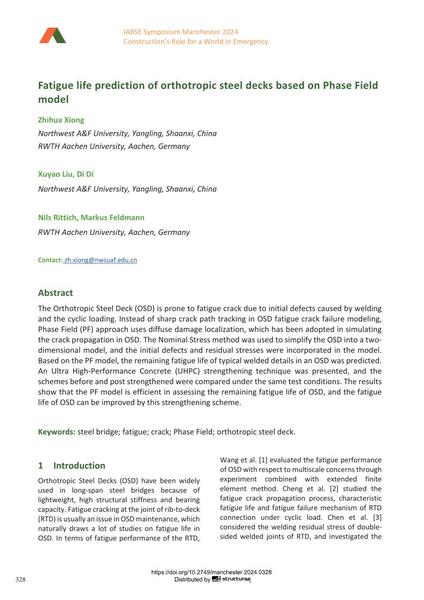Fatigue life prediction of orthotropic steel decks based on Phase Field model

|
|
|||||||||||
Détails bibliographiques
| Auteur(s): |
Zhihua Xiong
(Northwest A&F University, Yangling, Shaanxi, China RWTH Aachen University, Aachen, Germany)
Xuyao Liu (Northwest A&F University, Yangling, Shaanxi, China) Di Di (Northwest A&F University, Yangling, Shaanxi, China) Nils Rittich (RWTH Aachen University, Aachen, Germany) Markus Feldmann (RWTH Aachen University, Aachen, Germany) |
||||
|---|---|---|---|---|---|
| Médium: | papier de conférence | ||||
| Langue(s): | anglais | ||||
| Conférence: | IABSE Symposium: Construction’s Role for a World in Emergency, Manchester, United Kingdom, 10-14 April 2024 | ||||
| Publié dans: | IABSE Symposium Manchester 2024 | ||||
|
|||||
| Page(s): | 328-335 | ||||
| Nombre total de pages (du PDF): | 8 | ||||
| DOI: | 10.2749/manchester.2024.0328 | ||||
| Abstrait: |
The Orthotropic Steel Deck (OSD) is prone to fatigue crack due to initial defects caused by welding and the cyclic loading. Instead of sharp crack path tracking in OSD fatigue crack failure modeling, Phase Field (PF) approach uses diffuse damage localization, which has been adopted in simulating the crack propagation in OSD. The Nominal Stress method was used to simplify the OSD into a two- dimensional model, and the initial defects and residual stresses were incorporated in the model. Based on the PF model, the remaining fatigue life of typical welded details in an OSD was predicted. An Ultra High-Performance Concrete (UHPC) strengthening technique was presented, and the schemes before and post strengthened were compared under the same test conditions. The results show that the PF model is efficient in assessing the remaining fatigue life of OSD, and the fatigue life of OSD can be improved by this strengthening scheme. |
||||
| Mots-clé: |
pont en acier
|
||||
